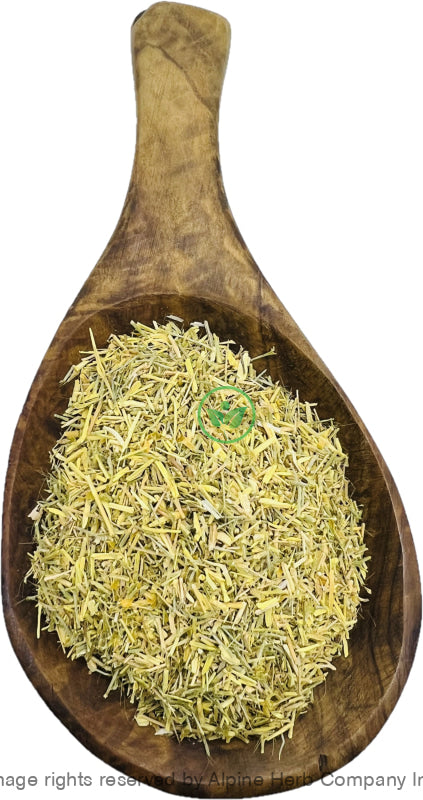Fagonia Arabica Herb Cut (Dhamasa) Alpine Herb Company Inc.
$ 8,99 $ 5,39
Botanical Name: Fagonia arabica
Common Name:
- English: Khorasan thorn
- Ayurvedic: Dhanvayaasa, Dhanvayavaasa, Dhanvayaasaka, Duraalabhaa, Samudraantaa, Gaandhaari, Gandhari,Dhanvayas,
- Unani: Dhamaasaa.
- Also, known as: Dhamasa, Dhamaasaa, Kachhuraa, Anantaa, Ananta, Duhsparshaa, Duhsparsa, Duralambha, Dhanvyasakah, Virupa, Duralabha, Durlabha, Dhamaaso, Damahan, Dhamaasa, Hinguaa, Dhanhare, Kodittuva, Dama, Dhamah, Dhamaha, Tulganari, Chittigava, Gilaregati, Badavard, Baadaaward, Shawka al-Baidaa, Shukaaa, Aqsoon, Fagonie, Fagonia, Dhamah, Dhamaha, Dama, Dhamaan, Damahan, Dhamhar, Dusparsha, Dramah, Dhamaya, Soochi Booti, Shokai, Kodittuva, Tulganari
Origin: India
Harvested: Wild
Parts Used: Entire plant
General Information:
Fagonia arabica is a short shrub that commonly grows in deserts. It is mostly mistaken for camel thorn, but both are very different altogether.
The tap root externally brownish green, rough, with longitudinal striations, centrally yellowish-green; fracture, fibrous. Length of stem pieces 0.3 to 1.4 cm thick, of flexible lengths. Green when they re young and brown when mature; two pairs of spines present at each node, spines sharp, slender, 1 to 2 cm in length; external surface of stem green and whitish brown when they dry, striated; transversely smoothened surface showing a thin bark and prominent wood, bark peeling from stem; fracture, short.Its leaves are small, subsessile, linear, and oblong.Entire leaflets are green or blackish brown, 0.5 to 1 cm in length and 0.05 to 0.15 cm in width, without any prominent midrib region projected above the level of lamina. Flowers are small, pale rose or purple, pedicels slender, 6 to 10 mm long; sepals 3 to 5 mm long, ovate, aristate; petals twice if the sepals, spathulate, claw long; ovary hairy, style tapering.
Historians believe that Arabs were the first people to have used this herb for medicinal purposes. It is also said that Indians were the first. The thought school remains divided on who discovered this herb, but no matter who did, this herb is widely used by a lot of people across the globe. Its benefits have been proven repeatedly and it has gained a lot of popularity and has come in the common use of the people. It has found its place in Ayurveda, homeopathy and even the modern medicine.
How to use:
Hot Infusion:
The basic method for dried herbs and flower is, take 2-3 tablespoons of dried herb in a cup or teapot. Pour hot water over it and cover it with lid for 10-30 minutes. Hot water is needed to draw out the antioxidants, enzymes, vitamins, flavonoids, and volatile oils from the botanicals. Strain and squeeze out as much as liquid as possible and enjoy!
Tips:
- You can sweeten your herbal tea with a bit of honey, natural fruit juice, stevia leaves powder and or licorice root powder.
- You can make ice cubes or pops by freezing tea in ice trays or pop molds.
Precautions:
You should consult with a qualified healthcare practitioner before using any herbal products, particularly if you are pregnant, nursing, or on any medications.
All information on this website is for educational purposes ONLY.
This information has not been evaluated by Health Canada.
This information is not intended to diagnose, treat, cure, or prevent any disease.
| Unit Size | 100g, 200g, 400g, 1kg |
|---|
Prompt shipping and expert packing
Thanks to our longstanding association with UPS FedEx DHL as well as other leading global carriers, we can offer a variety shipping options. Our warehouse staff is highly trained and will be able to pack your goods in accordance with our precise and exact specifications. Your items will go through an exhaustive examination before they will be securely packaged before being delivered. We ship to hundreds of thousands of customers daily in different countries. This is a sign of our determination to become the largest online retailer worldwide. Warehouses and distribution centers are located throughout Europe as well as in the USA.
Note that orders containing multiple items are processed according to the particular item.
We will thoroughly inspect all items ordered before shipping. Most orders are shipped within 48 hours. The delivery time will be between 3 and 7 working days.
Returns
The stock market is always changing. It's not entirely managed by us since we're involved with several entities, including the factory and the storage. Therefore, the actual inventory could fluctuate at any moment. Please be aware that it is possible that your order could be out of stock after you've placed your order.
Our policy lasts for 30 days. If it's been more than 30 days since the date you purchased your item We're sorry to say that we can't offer you a full exchange or refund.
You can only return a product if it is unused and still in the same state as when you received it. The item should be in the original packaging.


































